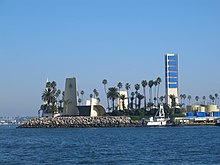THUMS Islands
The THUMS Islands consist of four man-made islands in San Pedro Bay off Long Beach , California . The name THUMS is made up of the first letters of the five oil companies that founded the operating company: T exaco (now Chevron ), H umble Oil (now ExxonMobil), U nion Oil (now Chevron), M obil (now ExxonMobil ) and S hell Oil Company . This operating company had the islands built and named them in 1967 after the four fatally injured NASA astronauts Theodore Freeman , who died in a plane crash, as well as Gus Grissom , Edward Higgins White and Roger B. Chaffee , the victims in the fire Apollo 1 capsule .
Signal Hill Oil Boom
After crude oil had been found in the then residential area of Signal Hill in 1921 , an oil boom developed, with the oil field known as "Porcupine Hill" being mined in the gardens, next to cemeteries and on other areas. Up until 1923, nearly 260,000 barrels of oil were being produced every day.
The Signal Hill oil field is still being mined today. Following a change in the law made possible by an election in 1962, Long Beach voters approved the use of the oil and gas reserves under their port that were part of the Signal Hill oil field, previously in a referendum in 1956 was still prohibited. However, this on the condition that four artificial islands should be created, which act like a tropical backdrop and hide the industrial buildings on it. They should blend in with the landscape and improve the look of the harbor, not impair it. The Wilmington oil field was developed by means of inclined drilling and water injection , and subsidence of the area was prevented.
THUMS Islands
The four islands together have a size of 42 acres (17 hectares ). There are around 1,000 active pumps on top of them, producing 46,000 barrels of oil and 250,000 cubic meters of gas every day . At the same time, water is pressed into the oil field by five pumps in order to keep the pressure in the oil bubble stable and to prevent Long Beach from sinking. The Wilmington oil field is the fourth largest oil field in the United States.
The islands were built from 640,000 tons of boulders and 3.2 million cubic meters of sand. Island Freeman is the largest with 5 hectares, the other three are around 4 hectares each. The boulders, weighing up to five tons, lie on the flat bottom of the harbor and form a small dike for each island. Initially, the large boulders were used to form an outer ring, which was then filled with sand raised from the bottom of the harbor. An irrigation system keeps over 700 palm trees alive, which are located in an outer ring around the inner production area. The artificial islands were designed in such a way that they look like natural islands in the bay, and the structures that are necessary to extract the oil and natural gas are camouflaged by simulated buildings or up to 30 m high waterfalls in the outer ring. These also serve to reduce the noise caused by the drilling so that Long Beach residents do not suffer. From the shore, these facades look like luxurious condominiums with lush vegetation. Joseph Linesch , who also worked on the landscaping of Disneyland in Anaheim, is responsible for a large part of the design . With his company Linesch & Reynolds and in collaboration with the sculptor Herbert J. Goldman and the landscape gardener Morgan Evans , Linesch produced the designs that were described in a local business newspaper as outstanding examples of modern industrial design.
Individual evidence
- ↑ Donald R. Prothero: California's Amazing Geology. CRC Press, 2017, ISBN 978-1-498-70792-3 , p. 376 ( limited preview in Google book search).
- ↑ a b c d THUMS - California's Hidden Oil Islands - American Oil & Gas Historical Society . In: American Oil & Gas Historical Society . 2018 ( aoghs.org ).
- ^ Signal Hill Oil Boom - American Oil & Gas Historical Society . In: American Oil & Gas Historical Society . 2018 ( aoghs.org ).
- ^ A b c Michael Gougis: THUMS Oil Islands: Half A Century Later, Still Unique, Still Iconic. In: lbbizjournal.com. Long Beach Business Journal, accessed January 4, 2019 .
- ↑ THUMS: California's Secret Oil Islands . In: Amusing Planet . ( amusingplanet.com ).
Web links
Coordinates: 33 ° 45 ′ N , 118 ° 9 ′ W


